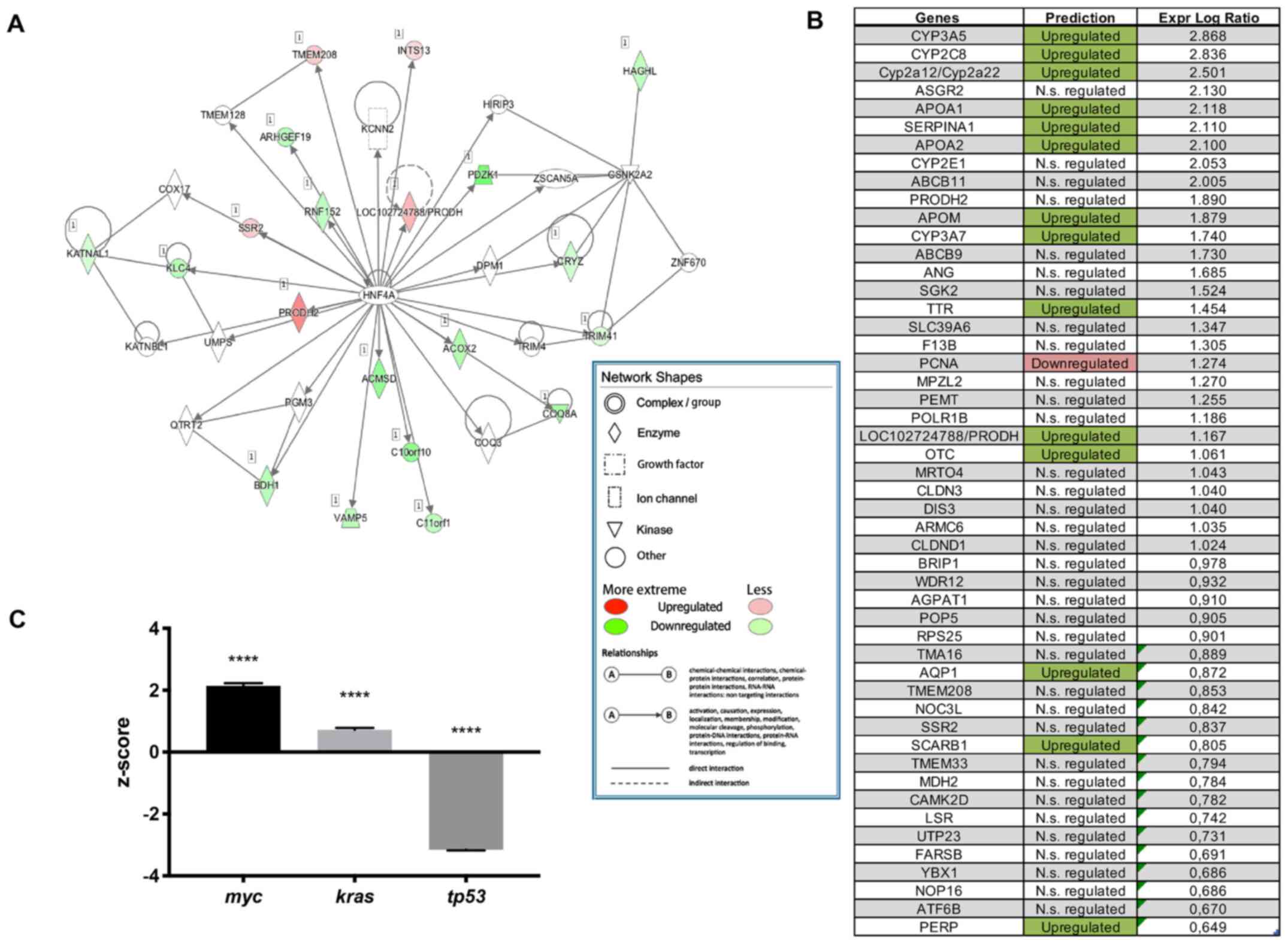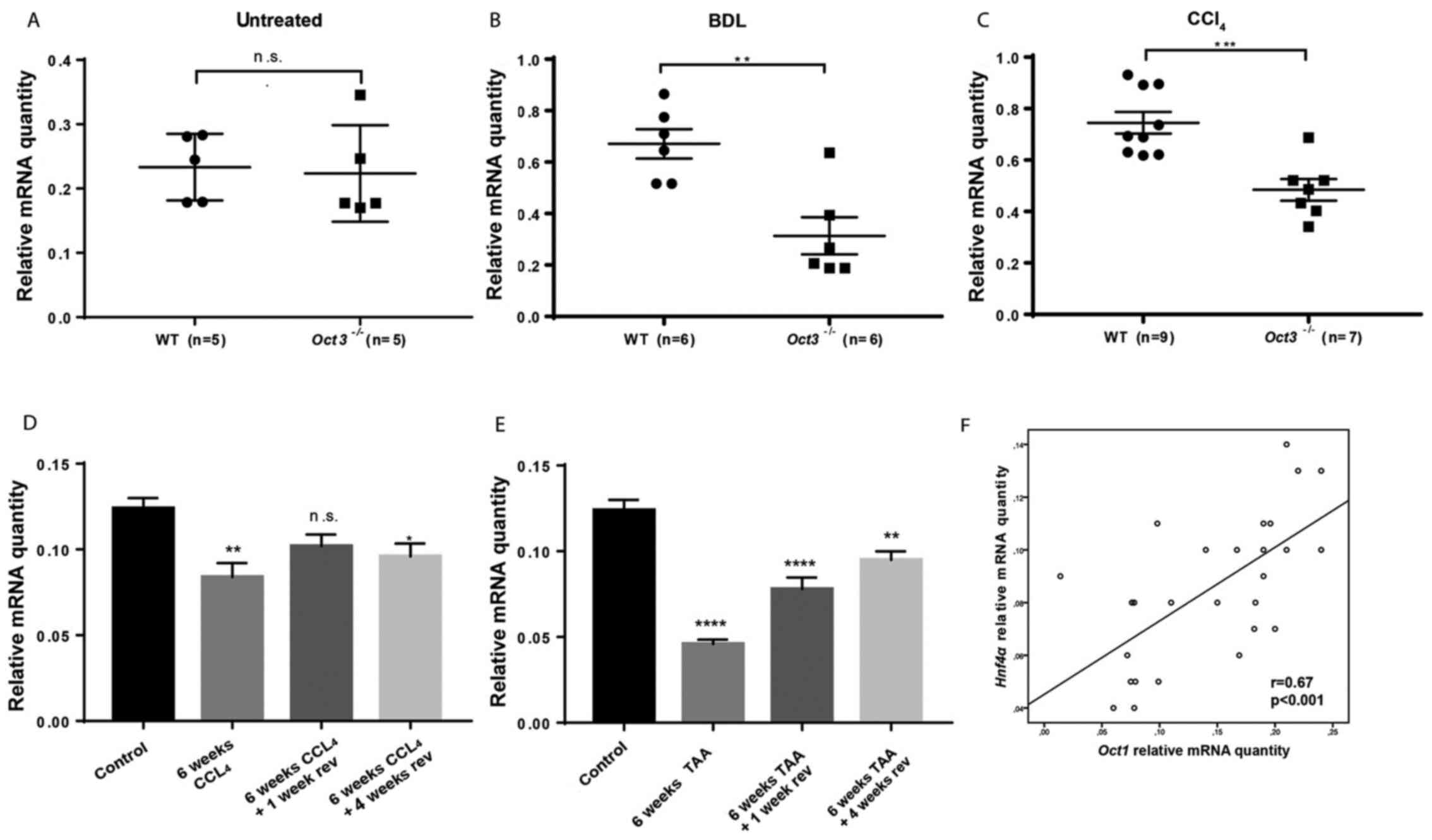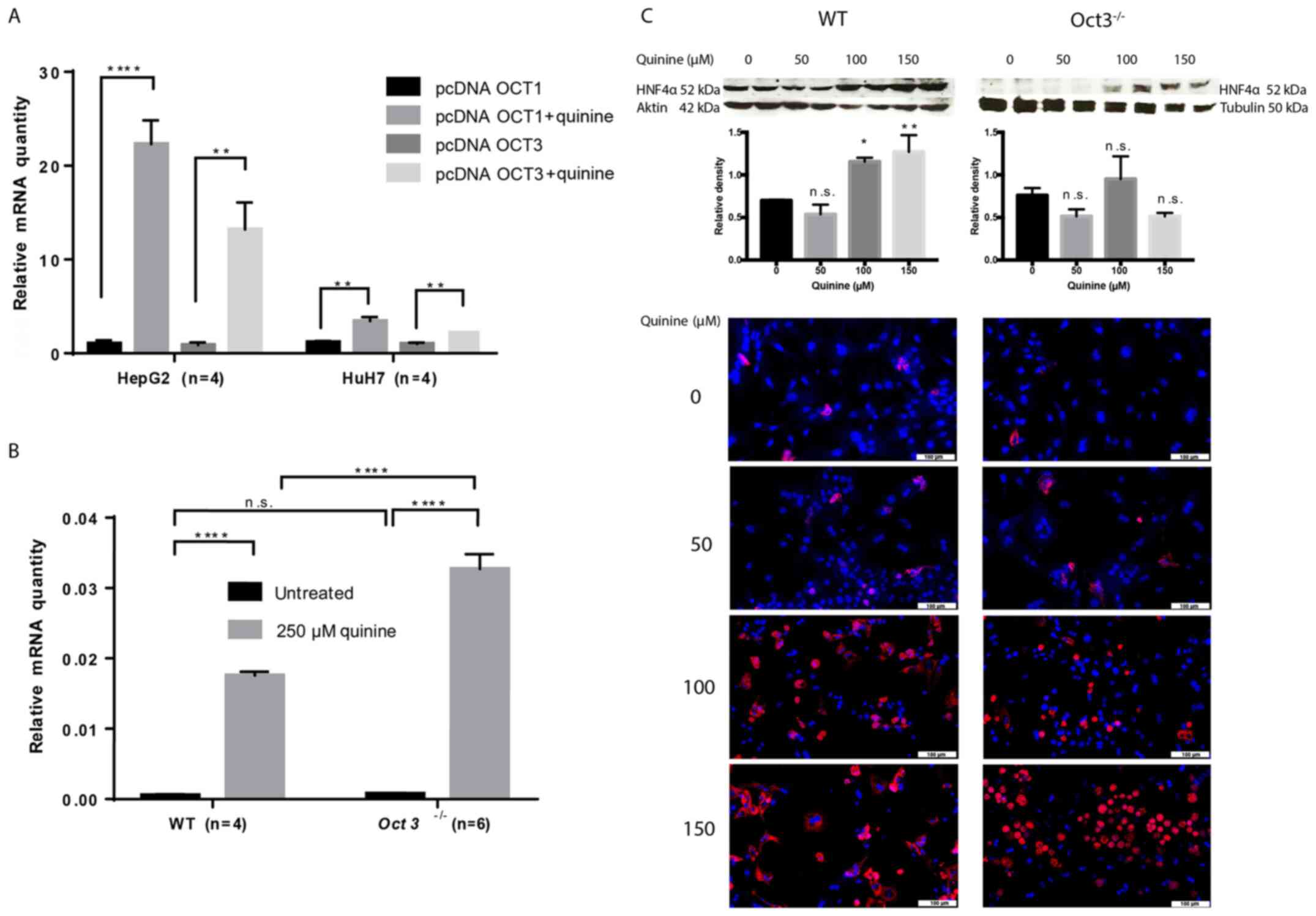|
1
|
Heise M, Lautem A, Knapstein J,
Schattenberg JM, Hoppe-Lotichius M, Foltys D, Weiler N, Zimmermann
A, Schad A, Gründemann D, et al: Downregulation of organic cation
transporters OCT1 (SLC22A1) and OCT3 (SLC22A3) in human
hepatocellular carcinoma and their prognostic significance. BMC
Cancer. 12(109)2012.PubMed/NCBI View Article : Google Scholar
|
|
2
|
Lautem A, Heise M, Gräsel A,
Hoppe-Lotichius M, Weiler N, Foltys D, Knapstein J, Schattenberg
JM, Schad A, Zimmermann A, et al: Downregulation of organic cation
transporter 1 (SLC22A1) is associated with tumor progression and
reduced patient survival in human cholangiocellular carcinoma. Int
J Oncol. 42:1297–1304. 2013.PubMed/NCBI View Article : Google Scholar
|
|
3
|
Grimm D, Lieb J, Weyer V, Vollmar J,
Darstein F, Lautem A, Hoppe-Lotichius M, Koch S, Schad A,
Schattenberg JM, et al: Organic Cation Transporter 1 (OCT1) mRNA
expression in hepatocellular carcinoma as a biomarker for sorafenib
treatment. BMC Cancer. 16(94)2016.PubMed/NCBI View Article : Google Scholar
|
|
4
|
Herraez E, Lozano E, Macias RI, Vaquero J,
Bujanda L, Banales JM, Marin JJ and Briz O: Expression of SLC22A1
variants may affect the response of hepatocellular carcinoma and
cholangiocarcinoma to sorafenib. Hepatology. 58:1065–1073.
2013.PubMed/NCBI View Article : Google Scholar
|
|
5
|
Vollmar J, Lautem A, Closs E, Schuppan D,
Kim YO, Grimm D, Marquardt JU, Fuchs P, Straub BK, Schad A, et al:
Loss of organic cation transporter 3 (Oct3) leads to enhanced
proliferation and hepatocarcinogenesis. Oncotarget.
8:115667–115680. 2017.PubMed/NCBI View Article : Google Scholar
|
|
6
|
Saborowski M, Kullak-Ublick GA and
Eloranta JJ: The human organic cation transporter-1 gene is
transactivated by hepatocyte nuclear factor-4alpha. J Pharmacol Exp
Ther. 317:778–785. 2006.PubMed/NCBI View Article : Google Scholar
|
|
7
|
Rulcova A, Krausova L, Smutny T, Vrzal R,
Dvorak Z, Jover R and Pavek P: Glucocorticoid receptor regulates
organic cation transporter 1 (OCT1, SLC22A1) expression via
HNF4alpha upregulation in primary human hepatocytes. Pharmacol Rep.
65:1322–1335. 2013.PubMed/NCBI View Article : Google Scholar
|
|
8
|
Parviz F, Matullo C, Garrison WD, Savatski
L, Adamson JW, Ning G, Kaestner KH, Rossi JM, Zaret KS and Duncan
SA: Hepatocyte nuclear factor 4alpha controls the development of a
hepatic epithelium and liver morphogenesis. Nat Genet. 34:292–296.
2003.PubMed/NCBI View
Article : Google Scholar
|
|
9
|
Sasaki S, Urabe M, Maeda T, Suzuki J, Irie
R, Suzuki M, Tomaru Y, Sakaguchi M, Gonzalez FJ and Inoue Y:
Induction of hepatic metabolic functions by a novel variant of
hepatocyte nuclear factor 4γ. Mol Cell Biol. 8:e00213–18.
2018.PubMed/NCBI View Article : Google Scholar
|
|
10
|
Ning BF, Ding J, Yin C, Zhong W, Wu K,
Zeng X, Yang W, Chen YX, Zhang JP, Zhang X, et al: Hepatocyte
nuclear factor 4 alpha suppresses the development of hepatocellular
carcinoma. Cancer Res. 70:7640–7651. 2010.PubMed/NCBI View Article : Google Scholar
|
|
11
|
Walesky C, Edwards G, Borude P,
Gunewardena S, O'Neil M, Yoo B and Apte U: Hepatocyte nuclear
factor 4 alpha deletion promotes diethylnitrosamine-induced
hepatocellular carcinoma in rodents. Hepatology. 57:2480–2490.
2013.PubMed/NCBI View Article : Google Scholar
|
|
12
|
Saha SK, Parachoniak CA, Ghanta KS,
Fitamant J, Ross KN, Najem MS, Gurumurthy S, Akbay EA, Sia D,
Cornella H, et al: Mutant IDH inhibits HNF-4alpha to block
hepatocyte differentiation and promote biliary cancer. Nature.
513:110–114. 2014.PubMed/NCBI View Article : Google Scholar
|
|
13
|
Wu N, Zhang YL, Wang HT, Li DW, Dai HJ,
Zhang QQ, Zhang J, Ma Y, Xia Q, Bian JM and Hang HL: Overexpression
of hepatocyte nuclear factor 4α in human mesenchymal stem cells
suppresses hepatocellular carcinoma development through
Wnt/β-catenin signaling pathway downregulation. Cancer Biol Ther.
17:558–565. 2016.PubMed/NCBI View Article : Google Scholar
|
|
14
|
Yue HY, Yin C, Hou JL, Zeng X, Chen YX,
Zhong W, Hu PF, Deng X, Tan YX, Zhang JP, et al: Hepatocyte nuclear
factor 4alpha attenuates hepatic fibrosis in rats. Gut. 59:236–246.
2010.PubMed/NCBI View Article : Google Scholar
|
|
15
|
Fan TT, Hu PF, Wang J, Wei J, Zhang Q,
Ning BF, Yin C, Zhang X, Xie WF, Chen YX and Shi B: Regression
effect of hepatocyte nuclear factor 4alpha on liver cirrhosis in
rats. J Dig Dis. 14:318–327. 2013.PubMed/NCBI View Article : Google Scholar
|
|
16
|
Park MR, Wong MS, Araúzo-Bravo MJ, Lee H,
Nam D, Park SY, Seo HD, Lee SM, Zeilhofer HF, Zaehres H, et al:
Oct4 and Hnf4α-induced hepatic stem cells ameliorate chronic liver
injury in liver fibrosis model. PLoS One.
14(e0221085)2019.PubMed/NCBI View Article : Google Scholar
|
|
17
|
Zwart R, Verhaagh S, Buitelaar M,
Popp-Snijders C and Barlow DP: Impaired activity of the
extraneuronal monoamine transporter system known as uptake-2 in
Orct3/Slc22a3-deficient mice. Mol Cell Biol. 21:4188–4196.
2001.PubMed/NCBI View Article : Google Scholar
|
|
18
|
Vollmar J, Kim YO, Marquardt JU, Becker D,
Galle PR, Schuppan D and Zimmermann T: Deletion of organic cation
transporter Oct3 promotes hepatic fibrosis via upregulation of
TGFβ. Am J Physiol Gastrointest Liver Physiol. 317:G195–G202.
2019.PubMed/NCBI View Article : Google Scholar
|
|
19
|
Jonker JW and Schinkel AH: Pharmacological
and physiological functions of the polyspecific organic cation
transporters: OCT1, 2, and 3 (SLC22A1-3). J Pharmacol Exp Ther.
308:2–9. 2004.PubMed/NCBI View Article : Google Scholar
|
|
20
|
Jonker JW, Wagenaar E, Van Eijl S and
Schinkel AH: Deficiency in the organic cation transporters 1 and 2
(Oct1/Oct2 [Slc22a1/Slc22a2]) in mice abolishes renal secretion of
organic cations. Mol Cell Biol. 23:7902–7908. 2003.PubMed/NCBI View Article : Google Scholar
|
|
21
|
Moll P, Ante M, Seitz A and Reda T:
QuantSeq 3'mRNA sequencing for RNA quantification. Nat Methods.
12:2014.
|
|
22
|
Liao Y, Smyth GK and Shi W: The Subread
aligner: Fast, accurate and scalable read mapping by seed-and-vote.
Nucleic Acids Res. 41(e108)2013.PubMed/NCBI View Article : Google Scholar
|
|
23
|
Morgan M, Anders S, Lawrence M, Aboyoun P,
Pagès H and Gentleman R: ShortRead: A bioconductor package for
input, quality assessment and exploration of high-throughput
sequence data. Bioinformatics. 25:2607–2608. 2009.PubMed/NCBI View Article : Google Scholar
|
|
24
|
Love MI, Huber W and Anders S: Moderated
estimation of fold change and dispersion for RNA-seq data with
DESeq2. Genome Biol. 15(550)2014.PubMed/NCBI View Article : Google Scholar
|
|
25
|
Kim YO, Popov Y and Schuppan D: Optimized
mouse models for liver fibrosis. Methods Mol Biol. 1559:279–296.
2017.PubMed/NCBI View Article : Google Scholar
|
|
26
|
Nies AT, Koepsell H, Winter S, Burk O,
Klein K, Kerb R, Zanger UM, Keppler D, Schwab M and Schaeffeler E:
Expression of organic cation transporters OCT1 (SLC22A1) and OCT3
(SLC22A3) is affected by genetic factors and cholestasis in human
liver. Hepatology. 50:1227–1240. 2009.PubMed/NCBI View Article : Google Scholar
|
|
27
|
Denk GU, Soroka CJ, Mennone A, Koepsell H,
Beuers U and Boyer JL: Down-regulation of the organic cation
transporter 1 of rat liver in obstructive cholestasis. Hepatology.
39:1382–1389. 2004.PubMed/NCBI View Article : Google Scholar
|
|
28
|
Tag CG, Sauer-Lehnen S, Weiskirchen S,
Borkham-Kamphorst E, Tolba RH, Tacke F and Weiskirchen R: Bile duct
ligation in mice: induction of inflammatory liver injury and
fibrosis by obstructive cholestasis. J Vis Exp: 52438, 2015.
|
|
29
|
Li WC, Ralphs KL and Tosh D: Isolation and
culture of adult mouse hepatocytes. Methods Mol Biol. 633:185–196.
2010.PubMed/NCBI View Article : Google Scholar
|
|
30
|
Arndt P, Volk C, Gorboulev V, Budiman T,
Popp C, Ulzheimer-Teuber I, Akhoundova A, Koppatz S, Bamberg E,
Nagel G and Koepsell H: Interaction of cations, anions, and weak
base quinine with rat renal cation transporter rOCT2 compared with
rOCT1. Am J Physiol Renal Physiol. 281:F454–F468. 2001.PubMed/NCBI View Article : Google Scholar
|
|
31
|
Müller J, Lips KS, Metzner L, Neubert RH,
Koepsell H and Brandsch M: Drug specificity and intestinal membrane
localization of human organic cation transporters (OCT). Biochem
Pharmacol. 70:1851–1860. 2005.PubMed/NCBI View Article : Google Scholar
|
|
32
|
Koepsell H: Polyspecific organic cation
transporters: Their functions and interactions with drugs. Trends
Pharmacol Sci. 25:375–381. 2004.PubMed/NCBI View Article : Google Scholar
|
|
33
|
Koepsell H, Lips K and Volk C:
Polyspecific organic cation transporters: structure, function,
physiological roles, and biopharmaceutical implications. Pharm Res.
24:1227–1251. 2007.PubMed/NCBI View Article : Google Scholar
|
|
34
|
Keller T, Elfeber M, Gorboulev V,
Reiländer H and Koepsell H: Purification and functional
reconstitution of the rat organic cation transporter OCT1.
Biochemistry. 44:12253–12263. 2005.PubMed/NCBI View Article : Google Scholar
|
|
35
|
van der Velden M, Bilos A, van den Heuvel
JJMW, Rijpma SR, Hurkmans EGE, Sauerwein RW, Russel FGM and
Koenderink JB: Proguanil and cycloguanil are organic cation
transporter and multidrug and toxin extrusion substrates. Malar J.
16(422)2017.PubMed/NCBI View Article : Google Scholar
|
|
36
|
Hilgendorf C, Ahlin G, Seithel A,
Artursson P, Ungell AL and Karlsson J: Expression of thirty-six
drug transporter genes in human intestine, liver, kidney, and
organotypic cell lines. Drug Metab Dispos. 35:1333–1340.
2007.PubMed/NCBI View Article : Google Scholar
|
|
37
|
Hagos Y, Wegner W, Kuehne A, Floerl S,
Marada VV, Burckhardt G and Henjakovic M: HNF4α induced
chemosensitivity to oxaliplatin and 5-FU mediated by OCT1 and CNT3
in renal cell carcinoma. J Pharm Sci. 103:3326–3334.
2014.PubMed/NCBI View Article : Google Scholar
|
|
38
|
Gasser PJ and Lowry CA: Organic cation
transporter 3: A cellular mechanism underlying rapid, non-genomic
glucocorticoid regulation of monoaminergic neurotransmission,
physiology, and behavior. Horm Behav. 104:173–182. 2018.PubMed/NCBI View Article : Google Scholar
|
|
39
|
Sleutels F, Tjon G, Ludwig T and Barlow
DP: Imprinted silencing of Slc22a2 and Slc22a3 does not need
transcriptional overlap between Igf2r and Air. EMBO J.
22:3696–3704. 2003.PubMed/NCBI View Article : Google Scholar
|
|
40
|
Sleutels F, Zwart R and Barlow DP: The
non-coding Air RNA is required for silencing autosomal imprinted
genes. Nature. 415:810–813. 2002.PubMed/NCBI View Article : Google Scholar
|
|
41
|
Chen L, Shu Y, Liang X, Chen EC, Yee SW,
Zur AA, Li S, Xu L, Keshari KR, Lin MJ, et al: OCT1 is a
high-capacity thiamine transporter that regulates hepatic steatosis
and is a target of metformin. Proc Natl Acad Sci USA.
111:9983–9988. 2014.PubMed/NCBI View Article : Google Scholar
|
|
42
|
Chen L, Hong C, Chen EC, Yee SW, Xu L,
Almof EU, Wen C, Fujii K, Johns SJ, Stryke D, et al: Genetic and
epigenetic regulation of the organic cation transporter 3, SLC22A3.
Pharmacogenomics J. 13:110–120. 2013.PubMed/NCBI View Article : Google Scholar
|
|
43
|
Nagano T, Mitchell JA, Sanz LA, Pauler FM,
Ferguson-Smith AC, Feil R and Fraser P: The Air noncoding RNA
epigenetically silences transcription by targeting G9a to
chromatin. Science. 322:1717–1720. 2008.PubMed/NCBI View Article : Google Scholar
|

















